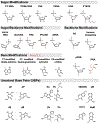Improving DNA nanostructure stability: A review of the biomedical applications and approaches
- PMID: 38228209
- PMCID: PMC11060068
- DOI: 10.1016/j.ijbiomac.2024.129495
Improving DNA nanostructure stability: A review of the biomedical applications and approaches
Abstract
DNA's programmable, predictable, and precise self-assembly properties enable structural DNA nanotechnology. DNA nanostructures have a wide range of applications in drug delivery, bioimaging, biosensing, and theranostics. However, physiological conditions, including low cationic ions and the presence of nucleases in biological systems, can limit the efficacy of DNA nanostructures. Several strategies for stabilizing DNA nanostructures have been developed, including i) coating them with biomolecules or polymers, ii) chemical cross-linking of the DNA strands, and iii) modifications of the nucleotides and nucleic acids backbone. These methods significantly enhance the structural stability of DNA nanostructures and thus enable in vivo and in vitro applications. This study reviews the present perspective on the distinctive properties of the DNA molecule and explains various DNA nanostructures, their advantages, and their disadvantages. We provide a brief overview of the biomedical applications of DNA nanostructures and comprehensively discuss possible approaches to improve their biostability. Finally, the shortcomings and challenges of the current biostability approaches are examined.
Keywords: Biomedical applications; Biostability; DNA nanostructures; DNA nucleases.
Copyright © 2024 Elsevier B.V. All rights reserved.
Conflict of interest statement
Declaration of competing interest The authors declare that they have no known competing financial interests or personal relationships that could have appeared to influence the work reported in this paper.
Figures







Similar articles
-
Self-assembled Nucleic Acid Nanostructures for Biomedical Applications.Curr Top Med Chem. 2022;22(8):652-667. doi: 10.2174/1568026622666220321140729. Curr Top Med Chem. 2022. PMID: 35319373 Review.
-
DNA nanotechnology-based nucleic acid delivery systems for bioimaging and disease treatment.Analyst. 2024 Jan 29;149(3):599-613. doi: 10.1039/d3an01871g. Analyst. 2024. PMID: 38221846 Review.
-
Construction of rolling circle amplification products-based pure nucleic acid nanostructures for biomedical applications.Acta Biomater. 2023 Apr 1;160:1-13. doi: 10.1016/j.actbio.2023.02.005. Epub 2023 Feb 9. Acta Biomater. 2023. PMID: 36764595 Review.
-
Strategies for Stabilizing DNA Nanostructures to Biological Conditions.Chembiochem. 2019 Sep 2;20(17):2191-2197. doi: 10.1002/cbic.201900075. Epub 2019 Jun 14. Chembiochem. 2019. PMID: 30875443
-
DNA Nanotechnology-Enabled Drug Delivery Systems.Chem Rev. 2019 May 22;119(10):6459-6506. doi: 10.1021/acs.chemrev.7b00663. Epub 2018 Feb 21. Chem Rev. 2019. PMID: 29465222 Review.
Cited by
-
Identification of Conjugated Dienes of Fatty Acids in Vischeria sp. IPPAS C-70 under Oxidative Stress.Int J Mol Sci. 2024 Mar 13;25(6):3239. doi: 10.3390/ijms25063239. Int J Mol Sci. 2024. PMID: 38542213 Free PMC article.
-
DNA-based hydrogels for bone regeneration: A promising tool for bone organoids.Mater Today Bio. 2025 Jan 19;31:101502. doi: 10.1016/j.mtbio.2025.101502. eCollection 2025 Apr. Mater Today Bio. 2025. PMID: 39911372 Free PMC article. Review.
-
Synthesis and Characterization of DNA Nanostructures and Their Cellular Uptake.Methods Mol Biol. 2025;2901:1-12. doi: 10.1007/978-1-0716-4394-5_1. Methods Mol Biol. 2025. PMID: 40175863
-
Triggerless Bio-Orthogonal Proximity-Induced PNA Ligation Using 2,5-Dioxopentanyl (DOP) Functionality.Methods Mol Biol. 2025;2901:227-239. doi: 10.1007/978-1-0716-4394-5_17. Methods Mol Biol. 2025. PMID: 40175879
-
Advances in programmable DNA nanostructures enabling stimuli-responsive drug delivery and multimodal biosensing.RSC Chem Biol. 2025 Jun 17;6(9):1366-1385. doi: 10.1039/d5cb00057b. eCollection 2025 Aug 27. RSC Chem Biol. 2025. PMID: 40585578 Free PMC article. Review.
References
-
- Kuang H, Xu C, DNA-based chiral nanostructures, in: Chiral Nanomater. Prep. Prop. Appl, 2017: pp. 179–221. 10.1002/9783527682782.ch7. - DOI
-
- Sharma A, Vaghasiya K, Verma RK, Yadav AB, DNA nanostructures: Chemistry, self-assembly, and applications, Elsevier Inc., 2018. 10.1016/B978-0-323-51254-1.00003-8. - DOI
Publication types
MeSH terms
Substances
Grants and funding
LinkOut - more resources
Full Text Sources

